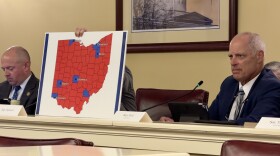The first meeting for the Ohio Redistricting Commission for this congressional map redraw will happen on Tuesday, Oct. 21, at the order of Gov. Mike DeWine.
DeWine, Secretary of State Frank LaRose and Auditor Keith Faber, all Republican executive officeholders, are on the panel. They're joined by legislative members Rep. Brian Stewart (R-Ashville), House Minority Leader Dani Isaacsohn (D-Cincinnati), Senate Minority Leader Nickie Antonio (D-Lakewood) and a Republican senator who has yet to be named.
One big question is whether the commission will consider a congressional map that can be accepted by the two Democrats on the panel, which is a requirement for this stage of the process or it moves to the full General Assembly.
House Speaker Matt Huffman (R-Lima) said Tuesday’s meeting will involve formal actions, but he isn’t promising a map yet, though he said he would like to have a map available.
“If there’s a proposal that I think members of the redistricting commission can collectively pass, we would probably present that at that meeting," Huffman said. “My hope, maybe add the word aspiration, is that we try to have a bill passed. I mean that’s the whole point of this three part system."
But Isaacsohn noted that's not a commitment, and that Republicans didn't produce a map in September for the legislative panel that concluded without an agreement on Sept. 30. Isaacsohn said voters in 2018 intended for debate on maps during the first two phases of the three-part process.
“They want to see legislators produce maps, propose them, debate them, negotiate them, come to something that feels fair and representative," Isaacsohn said.
Democrats had introduced a map in September that would likely produced eight Republican and seven Democratic districts in most years. Ohio's current congressional map is 10-5, Republicans to Democrats. Isaacsohn said the pattern nationwide indicates where Ohio Republicans might be trying to take things.
“Instead of trying to run on their record, they are trying to steal congressional districts all over the country, and that means in Ohio, if they did what they did in Texas and Missouri, they would take us to a 13-2 map," Isaacsohn said.
If lawmakers don’t come to a bipartisan agreement on a map before the end of this month, supermajority Republican lawmakers can pass a map without a single Democratic vote, though the map would only last for six years.





